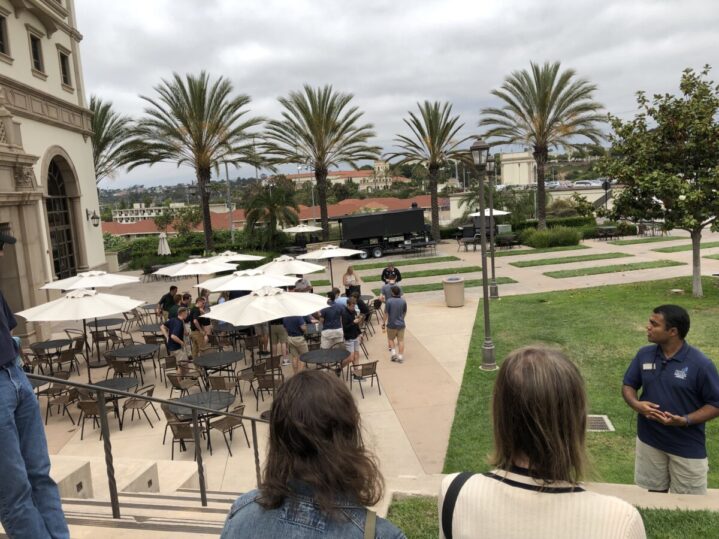
College tour in California
Choosing a college (or not choosing) is perhaps the first big life-decision for many youngsters. My son is going to be a senior at high school and he is planning to go to college. In order to make the decision, he has to answer a series of questions: which country, which part of the country, which college, big or small, urban or rural, public or private, conservative or liberal, and above all what he wants to study, what he expects to achieve, and what he wants to do with his life. And my son doesn’t have answers for most of these questions.
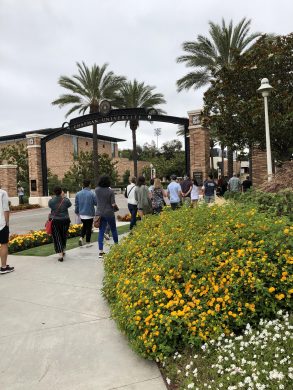 I am not blaming him for not knowing. What do you expect from a seventeen year old boy? Some may know exactly what they want, but many don’t. As for me, I thought I knew, but looking back, my college choice was the only practical option available within my small world. I wish I could have explored more.
I am not blaming him for not knowing. What do you expect from a seventeen year old boy? Some may know exactly what they want, but many don’t. As for me, I thought I knew, but looking back, my college choice was the only practical option available within my small world. I wish I could have explored more.
At least, my son knows he wants to go to the US. When asked by a school counsellor, he answered “100%” without hesitation. But the rest is a blur. He doesn’t have any specific major or school in mind. Somewhere small and somewhere warm are the only standards he has set at this moment. (Oh, and sports. He wants to play baseball in college. But this is another long story. That is my husband’s department). He was participating in a sports camp in southern California this summer and between the camp and tournaments, we squeezed in college tours.
This is the second round of college tours for us. I have a daughter who is a junior at a college in Florida. We did the same for her over the summer of her junior year, and visited nearly ten colleges. (Her primary standards were somewhere small and somewhere warm. It seems the same trait runs in the family). When my husband first suggested to take her for a college tour in the US, I thought that was quite extravagant. The colleges on her list were not next to each other: we had to fly to California, Texas, Florida, and they are not necessarily conveniently located. It was a big trip. Yet considering she had never lived in the US, and didn’t know much about US colleges, it seemed necessary to show her what they were like. Despite the time and money we spent, it turned out that the tours helped her tick off colleges, “No” rather than “Yes.” She applied for only one college among those visited. I guess you can say, “better than nothing”. A decision can be made by a process of elimination.
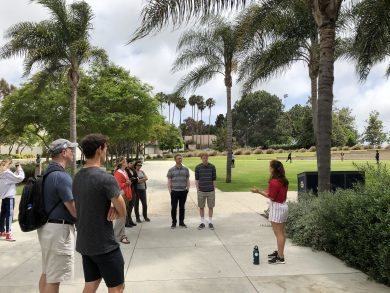
College tours usually consist of half an hour orientation, video or Powerpoint presentation by an administrator and followed by Q and A. Then, a student guide takes a group of 10-15 people to walk around the campus for an hour or so. They usually provide tours every day and you can book the tour ahead online. The colleges we visited had 30-50 people in one tour and I was surprised to see how many candidates those schools host over the summer, because some were quite small schools. Unlike his sister, my son didn’t tick them off “No.” His comment after visiting each college was “Nice.” I am not sure why teenage boys tend to answer questions with one word. Especially when the word has a wide range of implications, from “nice, but no thank you” to “nice, I like it.” Actually, all campuses we visited were just “nice.”
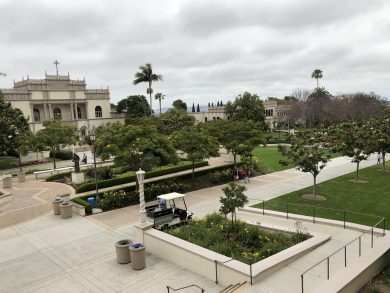
The campuses were beautiful, with green grass and palm trees (California!), and often with water fountains. I didn’t see any of the “shabby” old buildings I studied in during my school days. At one campus located on a small hill on the coast, we overlooked a beach from the terrace of the school cafeteria. All you could see was blue sky and sea: if you were at a spa instead of a library, you would think you were at a resort hotel.
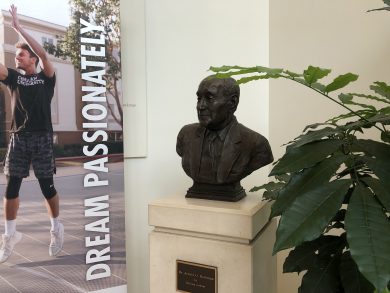 All school cafeterias featured healthy organic food including salad bars and vegan menus. There were still pizzas, spaghetti and burgers, staple of school cafeterias, but they were quite sophisticated: pizzas were baked in the oven in an open kitchen and burgers were grilled in front of you. (My son ordered a hamburger and was asked how he would like his burger to be cooked). You could see that schools were trying to provide more than good nutrition. In order to cater for everyone’s taste, there were booths for Mexican, Chinese, Italian, Greek, and Sushi dishes(!). My notion of a school cafeteria, cheap and bland, has changed.
All school cafeterias featured healthy organic food including salad bars and vegan menus. There were still pizzas, spaghetti and burgers, staple of school cafeterias, but they were quite sophisticated: pizzas were baked in the oven in an open kitchen and burgers were grilled in front of you. (My son ordered a hamburger and was asked how he would like his burger to be cooked). You could see that schools were trying to provide more than good nutrition. In order to cater for everyone’s taste, there were booths for Mexican, Chinese, Italian, Greek, and Sushi dishes(!). My notion of a school cafeteria, cheap and bland, has changed.
The sports facilities were well equipped. I didn’t see much difference from Bangkok’s private sports gyms. In addition to new machines, they provide free (well, included in the tuition fees) fitness lessons such as yoga or Pilates. Other bells and whistles include: music halls and theatres with great sound systems; health centres for both physical and mental health needs; shuttle buses to nearby downtown and shopping malls; 24 hour safety call systems; and, individual tutoring.
 Colleges have joined the service industry rather than being purely educational institutes. We are the customers, rather than students. When I went to college 30 plus years ago in Japan, I don’t think colleges tours were offered. At least, I didn’t join. Colleges were still in the ivory tower and their attitudes was “you come to me” or “you can come if you wish” at best. Now these schools are saying “We would like you to come, please” or “How can we get you interested?” as the number of US students entering college has been in decline for the last decade and the industry has become very competitive.
Colleges have joined the service industry rather than being purely educational institutes. We are the customers, rather than students. When I went to college 30 plus years ago in Japan, I don’t think colleges tours were offered. At least, I didn’t join. Colleges were still in the ivory tower and their attitudes was “you come to me” or “you can come if you wish” at best. Now these schools are saying “We would like you to come, please” or “How can we get you interested?” as the number of US students entering college has been in decline for the last decade and the industry has become very competitive.
Their PR was upbeat. I don’t know how many times I heard “our school is ranked number one (or two or three) in this and that (a top academic programme, a most beautiful campus, a most delicious cafeteria, etc.).” I wonder how many ranking agencies exist in the US.
What a difference. I know I shouldn’t compare the US colleges of today with my experience since they are in different countries, different contexts, and different times. But still.
Perhaps, this is partly a byproduct of rising cost of America’s higher education. It is horrendous. According to College Board, the average cost for private colleges is $53,000 and public colleges (out-of-state) is $42,000. (One college we visited stated $73,000)! I remember someone asking “is this a cost for one year?” at a high school workshop. It sounds like the cost for four years. But no, it’s just for one year. Financial aid is available, but full scholarships are given to only a handful of students, and you may have heard that default of student loans is a huge issue in the US. When the individual has to shoulder such a financial burden, higher education institutes’ role for the public good is eclipsed by the need to serve the individual.
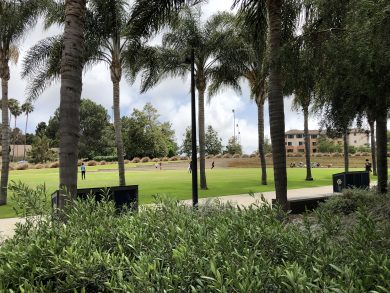
Each college presented its educational programmes and how great its education and research is. Yet academics is not the only major agenda item, but just one of many sales points. Graduating from their college as a means to get a good job was always emphasised. They all highlighted the convenience of their location to major industries nearby (we went to L.A. and San Diego), so that students can intern or work part-time jobs to build their networks. Of course that is an important practical purpose of sending a kid to college and I hope my children will be employable upon graduation.
But at the same time, I am an old-fashioned idealist. I expect colleges provide more than vocational skills. An ivory tower is a great place to think about their lives, as a human being a human: who they are, what they want, the world they live in, the people around them and the future.
On the way to a college, we chatted with our Uber driver. When he saw us off, he said to my son, “You are a lucky guy. Not many people have that chance”. That was the most memorable moment on this college tour. I hope my son took his words to heart and finds a way to return it to others, wherever he decides to go.



